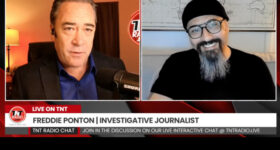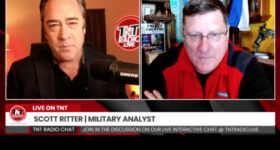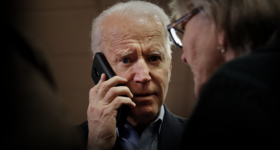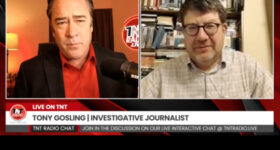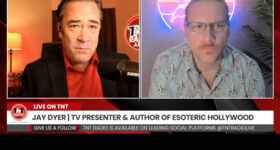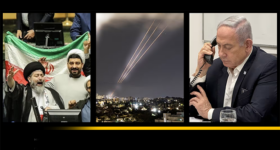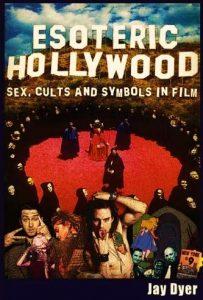 Jay Dyer
Jay Dyer
21st Century Wire
Following the success of the 1974 extreme shock and awe horror Texas Chainsaw Massacre, director Tobe Hooper was recruited to direct a Spielberg project called Poltergeist that would be as much of a game-changer for the horror genre as Chainsaw. Texas Chainsaw Massacre, however, was an innovation in the genre that pushed the limits of what censors were willing to tolerate.
While the film admittedly has several technical achievements worthy of note for a miniscule 60k dollar budget, the overall repulsion and disgust present in every scene makes it hard to deny the film truly is nihilistic meaninglessness dressed up as avant-garde.
In relation to Poltergeist, two aspects of Chainsaw Massacre are worth mentioning. First, there is an occult aspect to the film many often overlook – consistent references to astrological signs and dates portend the dark cannibal ritual that closes the film. A kind of preternatural, almost organic evil seems to arise from this hopeless backwards inbred family, suggesting something akin to a dark version of the theological direct vision of God. The film is also a loose representation of the tale of Ed Gein (for those who aren’t aware) – as was Norman Bates in Hitchcock’s Psycho.
For the possessed rednecks of Chainsaw, they almost have a direct vision of evil itself, seemingly knowledgeable of occult practices without even being literate. There is even a Manson-esque quality to the travelling hitchhiker picked up at the beginning, while the girls mention Saturn’s predominance – a foreshadowing of the coming human sacrifice (long associated with Saturn-worship).
Critic John Muir highlights the emphasis in Hooper on black magic and the occult. Muir also comments that Hooper suggested the cooperation with Spielberg on the film due to an occult text he found, as well as Spielberg’s interest in such phenomena. (Eaten Alive at a Chainsaw Massacre: The Films of Tobe Hooper, 24):
“Hooper’s films often view television as a portal to evil. Sometimes the images on the television represent a danger to come (as The Funhouse showing an image of Bride of Frankenstein), and sometimes TV itself is a portal to evil (Poltergeist). ..Hooper’s many films show his love of magic and the occult. Everything from black magic to astrology is brought up as possible explanations for terror in his films. Texas Chainsaw Massacre (astrology), Salem’s Lot (magic), etc.” Ibid, 182.
The other interesting element from Hooper’s Chainsaw that is both bizarre and worthy of mention (without any clear explanation on my part) is brought to the fore by famed cult film critic Joe Bob Briggs:
“Everyone involved felt permanently changed – or, in some cases, scarred by the film. Ed Neal, who played the hitchhiker, could never again speak about it without being enraged. Robert Kuhn, a criminal attorney who invested in the film, would waste years fighting for the profits that should have poured into Austin but were instead siphoned off by a Mafia distribution company that absconded with the funds….Soon thereafter they learned the mob had absconded with most of the money – 12 million in less than a year – and that would probably never be paid.” Joe Bob Briggs Profoundly Disturbing Shocking Movies that Changed History, pg. 189, 195
The film eventually grossed 60 million. So, right off the bat before entering into Poltergeist we have three nefarious elements that all coalesce in the figure of Hooper: the Mob, the occult and cannibalism. While Poltergeist doesn’t have the mafia, it does have the occult, as well as numerous mystery aspects debated by film nerds I will opine on. Let us analyze.
Replete with patriotic USA themes and images, the setting for the film is an archetypal 1980s middle class suburbia embodied in the Cuesta Verde housing development. At the height of the Reagan era, Americanism is equated with “trickle-down” economics, football and the rampant consumerism embodied in the endless corporate logos that litter virtually every scene. MIddle class America in the 80s is worried about the “godless Soviet Empire” while simultaneously satiated with Pepsi, Bud Light, and Eggo Waffles, as well as awash in the NFL, pop music and movies, posters, and figurines for every film-based toy.
The obsession with television is central to the entire film and arguably one of the most revelatory self-aware and self-critical films I can think of. As arguments ensue between neighbors over which channel to settle on (due to signals being crossed), we are immediately given the impression the synthetic entertainment spectacle has replaced the family as the center of life, even in the midst of family life. Cuesta Verde architect Steven Freeling (Craig T. Nelson) has even managed to attain the 80s American goal of upper middle class – a TV in every room, and, as we soon discover, is well on his way to becoming upper class through the project’s success, with the promise of being a partner in the firm.
Unfortunately, for the Freelings, ominous events are on the horizon as evidenced in the death of Carol Anne’s parakeet. Unclear as to what death is, Carol Anne and her mother broach the topic with some difficulty resulting in Carol Anne’s flippant, giddy reprisal, “Oh well. Can I get a goldfish?!” Even young Carol Anne has imbibed the buy-consume-dispense mentality of her parents and culture, the very essence of consumerism which relegates all value to some form of appeasement of bodily appetites, be it through corporate foods or entertainment spectacles. Life has been negated through the promise of expansion – bigger housing developments, bigger televisions, bigger pools, bigger accounts, and it is here the central spiritual problem in the film arises – the disrespect for life, the natural world, the spirit and the afterlife.
An interesting paradox has thus become manifest: the promise of a better “life” that was engineered through monopoly capitalism (and more specifically the Rand Corporation) has given rise to the radical inverse, the most extreme form of evil and anti-life, the demonic. Buried in their false eden of material pleasures, the Freelings, as archetypal Americans embodying the mundane middle class and decadent petty bourgeoisie are in fact the truly deformed, and thus open to the influence and contact with the demonic. Nominally Christian, the Freelings are amazingly unaware of the most basic theological notions. For them, as for most Americanized religionists, theology is an unknown term, and things of the spirit are indistinguishable from psycho-babble. Evil certainly does not manifest as a real, malevolent force that seeks to rob humans of their life.
The Freeling parents are former hippies of the Weird Scenes generation that still smoke pot (recreationally), but by middle-aged maturity have combined this with their conservative Reaganomics – typical of the boomers. Even Steven’s masculinity is synthetic, as his sports obsession, faint interest in his kids and pale attempt at push-ups reveal almost everything for the Freelings is a mundane, passing gaze – like the flipping of television channels. They’ve got a TV in every room, though, and the children have every 80s toy imaginable – suggesting Steven has attempted to make up for his lack of presence in the home with gifts. In fact, in this very scene Diane (JoBeth Williams) discusses the problem of “sleepwalking,” which is clearly a metaphor for the spiritual state of the family, and America as a whole.
As an odd side note, Hooper’s view of the television as a portal to evil is curious, given William Crookes, one of the pioneers of the cathode ray tube (Crooke’s tube), which would be instrumental in the development of television, was a member of the Hermetic Order of the Golden Dawn. Crooke was an avid spiritualist, keenly interested in contacting the other side, and even became the president of The Society for Psychical Research in the 1890s. The SPR would pioneer the notion of “ghost hunting,” much like Poltergeist paved the way for pop culture “ghost hunting” shows.
As the spirits begin to cause manifestations and disturbances, the first “portal” seems to be some pathway from the television to the wall above the bed in the master bedroom. Admittedly speculation, but I wonder if this scene doesn’t suggest the heart of the marital relationship itself is what would come under attack – it is the bedroom which produced Carol Ane, and as we discover there are not only benevolent spirits visiting the Freelings, the opening of the portal in the bedroom suggests the demonic, the malevolent spirit (identified as “The Beast” in the sequel, who will seek the offspring of this sexual union as a sacrifice. In other words, read symbolically, the television, like a kind of portal of evil, will destroy the marital relationship and the offspring, the youth, will be the sacrifice – offered to “The Beast,” hearkening both to Crowley and biblical apocalypticism (as well as through the toxic culture the system promotes).
The film is also reminiscent of a Twilight Zone episode where a little girl disappears through a portal behind her bed, becoming trapped in the aether, requiring a rescue from one of the parents. The most significant aspect of the film, I believe, is that Carol Anne is intended by the Beast to be a virgin sacrifice. Note that Carol Ane even wears a white gown, suggesting a ritual vestment, yet even up to the third act the family is oblivious to what is happening – they cannot conceive that pure evil wants their offspring’s soul. Such as notion is too biblical, too ancient and superstitious.
After the failure of the university ghost hunter crew to diagnose the Freeling problems, medium Tangina Barrons (Zelda Rubenstein) arrives to offer strange advice “contrary to their Christian faith” that appears to work. While Barrons’ analysis is more accurate than the ghost hunters, the interesting contradiction occurs when Tangina yells to Carol Anne to both “stay away from the light” and “go to the light!” While this puzzled me for a bit, what actually works to return Carol Anne to this plane is Diane donning a “lifeline” rope, pulling her daughter back through the portal that evokes a rebirth. Spielberg’s screenplay even speaks of the “beast” as a giant body, which Diane appears to see one part of (hence the giant throat scene in the bedroom closet portal):
“Diane looks up into the face that forms and the hands that reach out to her and sees the beginning of the “great beast”. She retreats on her rear end backwards down the hall, pursued by the phantom twister.”
Carol Anne and Diane are now reborn, having worn a rope reminiscent of the high priest in the Law before entering the presence of God, or the “cable-tow” in Freemasonry. In this case, Diane and Carol Anne have seen the face of the Beast (not God), which, like the cable tow, echoes the biblical presentation when Diane’s hair has turned white from seeing the Beast directly (as when Moses’ hair turned white from seeing God on Sinai). In this sense, it seems the Freelings have experienced an occult rebirth, outlined not only in masonry, but in many esoteric groups (this is also shown in their continued spiritual problems in the shoddy sequels). The occult rebirth is also shown in the ritual bath Barrons commands, following their return.
Poltergeist is, on the one hand, a statement about the dismissal of the past, the sacred and sacramental, in life and in nature, for the dismal and disposable pseudo-culture of pop modernity. In this sense, the picture Hooper and Spielberg want to give is that, like The Shining, America as a whole is haunted and built on an Indian burial ground. The Freelings are forced to learn a hard lesson, as modern man must, that his preference for consumerism and materialism is a curse – a spiritual curse. In this regard, To add mystique to the story, there is even the famed rumor that the Poltergeist film crew was in some way cursed, given the numerous deaths and accidents that surround these three films – especially since Carol Anne (Heather O’Rourke) died mysteriously in real life:
READ MORE HOLLYWOOD NEWS AT: 21st Century Wire Hollywood Files
To hear Jay’s full podcasts, see more information and learn how you can become a subscriber to JaysAnalysis.
Jay Dyer is the author of the forthcoming title, Esoteric Hollywood: Sex, Cults and Symbols in Film from Trine Day. Focusing on film, philosophy, geopolitics and all things esoteric, JaysAnalysisand his podcast, “Esoteric Hollywood,” investigates the deeper meanings between the headlines, exploring the hidden aspects of our sinister synthetic mass media matrix.











